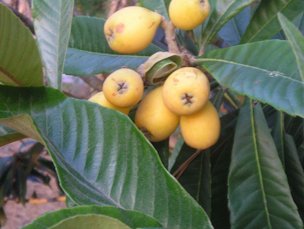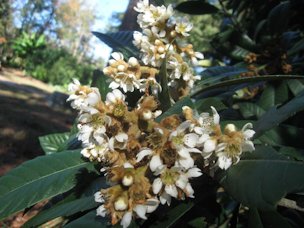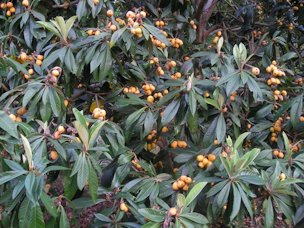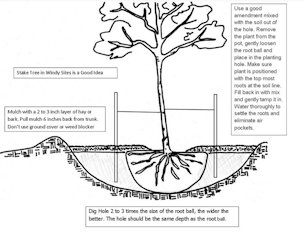Fact Sheet from
the Just Fruits and Exotics Nursery
by Brandy Cowley Gilbert
Choosing the
Right Loquat Variety

Fig. 1
'Christmas' variety
Loquats
are small evergreen trees with beautiful, coarsely textured leaves of
deepest jade green. The small white flowers open between October and
December – loquat flowers have an intense sweet scent. Winter
brings abundant crops of delicious pale yellow fruit with an apricot
flavor. Our loquat trees are cutting grown or grafted to insure
fruiting in two years. Use fresh in fruit salad, freeze, use in pies or
make jelly and jam. Loquats are one of the easiest, most problem-free
fruits you can grow – a little care will go a long way with
this
tree.

Fig. 2
Pollination
Loquats are self-pollinating.
Landscaping
with Loquat Trees…..
Loquats
grow to approximately 20 feet tall. With a small, rounded crown, the
graceful, evergreen trees have a distinctly tropical air. Combine with
ginger lilies, cycads or bananas to move your garden south. Use as a
small specimen tree or mix in with citrus varieties for a tall
evergreen hedge. Loquats look great near ponds or water features.

Fig. 3
Site
Selection and Correct Spacing for Loquat Trees
Well-drained
sandy soils are preferred, but loquats will grow on many soil types if
good drainage is provided. Loquats do not tolerate flooding. Trees will
grow more vigorously and produce more fruit in full sun.
Fig. 4 
Loquats
prefer slightly acid soil (pH 5.5-6.5), but soils of up to moderate
alkalinity are readily tolerated. If you are in doubt about the acidity
of your soil, take a soil sample to the Cooperative Extension Agent in
your county for a soil test. Dig a planting hole approximately three
times the width of the pot and at the same depth as the root ball. Set
that soil aside and mix it 50/50 with either aged mushroom compost,
aged manure or rotted pine bark & aged manure/compost. Remove
the
plant from the pot, gently loosen the root ball and place in the
planting hole. To avoid burying too deep, make sure plant is positioned
with the top most roots at the soil line. Fill the planting hole with
the mix of soil and organic matter; gently tamp it in. Water thoroughly
to settle the roots and eliminate air pockets. Do NOT put fertilizer in
the planting hole. Only apply fertilizer if it is the correct time of
year (see Fertilization section below).
Mulching…
If
desired, construct a water basin around the base of the tree
approximately 36 inches in diameter. Mulch in spring and summer with
approximately 4-6 inches of mulch. Pull mulch a couple of inches away
from the trunk for good air circulation.
Fertilizing
Loquat Trees
The
type of fertilizer you choose may be chemical or organic. Make sure
that the fertilizer contains iron, zinc, manganese, magnesium,
molybdenum, copper and boron. These minor elements are very important
to plants and most soils are low in these elements. Application rates
vary according to age of plant.
See chart below
| 10-10-10 or 10-0-10 with minerals |
1 cup per each year of trees life
Max out at 9 cups on Mature Trees |
Espoma Citrus Tone
(Organic) |
6 cups for 1 year old
10 cups for 2 year old (4-6ft)
18 cups for 7-9ft tree
24 cups for tree over 9ft |
Spread
the fertilizer evenly under the entire canopy of the plant avoiding a
5-inch area around the trunk. Water or rake in. For Zones 9-10,
fertilize 3 times each year in late February, late May and late
July/early August. For plants further north (Zones 7-8b), fertilize in
March or after bud break. Never fertilize after August (June in Zones
7-8b) as this will promote new growth late in the year which will be
subject to freeze damage.
Watering
Loquat Trees
The
first year is the critical time for the establishment of a new loquat.
Water thoroughly twice a week on light soils and once a week on clay
soils. Soak the entire root system deeply – this usually
takes
40-50 minutes. Loquats should receive at least 1 inch of water each
week for best growth and fruit production. Water regularly, especially
during dry periods. Fruit may drop prematurely if insufficiently
irrigated during dry spells.
Pruning
Loquat Trees
Loquats
require little pruning. Remove dead and damaged wood when appropriate.
Loquats are essentially free from pests and diseases. Freezes below
27°F may damage fruit and flowers, but will not harm the trees.
Learn How to
Control Insects and Diseases on Your Loquat Trees
Always
remember that good disease resistance begins with the health of the
plant. Plants stressed from lack of water, not enough sun or being
under fed are more susceptible to disease and insects. Maintaining good
sanitation practices in the orchard is most important. The removal of
diseased and dead wood, and picking up fallen or rotting fruit off the
trees as it occurs, will go a long way in keeping disease and insects
at a minimum. Spray at first sign of an issue, rather than waiting
until the problem is out of hand will go a long way to keeping your
plants healthy and fruiting properly.
Back to
Loquat Page
|
|
Bibliography
Gilbert, Cowley, Brandy. "Choosing the Right Loquat Variety." Just Fruits and Exotics, justfruitsandexotics.com. Accessed 18 Mar. 2015.
Photographs
Fig. 1,2,3,4 Gilbert, Cowley, Brandy. "Choosing the Right Loquat Variety." Just Fruits and Exotics, justfruitsandexotics.com. Accessed 18 Mar. 2015.
Published 18 Mar. 2015 LR. Last update 14 Mar. 2016 LR
|

